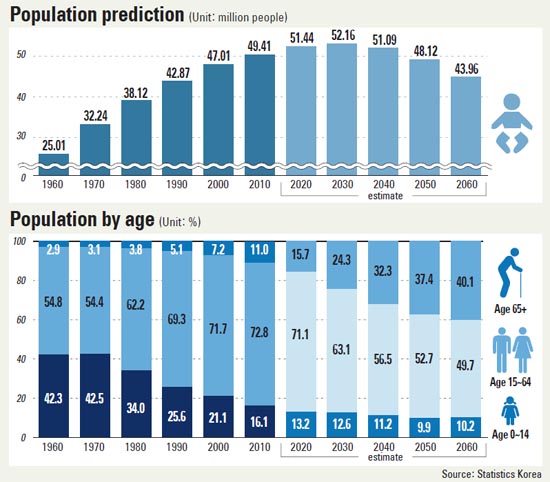Population peak pushed to 2030

Concerns about an aging society, however, still remain.
According to a report released by Statistics Korea yesterday, the country’s population is expected to steadily rise until 2030 and reach its peak, before falling gradually from the following year.
In 2030, Korea’s population is projected to peak at 52.16 million, up from 49.41 million at the end of last year. The number will start falling in 2031, and in 2060 will be as low as 43.96 million.
The latest forecast is less gloomy than a previous report released in 2005. At that time, the government expected the country’s population to peak in 2018 at 49.34 million, before starting a steady decline.
Statistics Korea noted several factors for the revised forecast.
Over the past five years, the overall birthrate has risen. The country’s life expectancy has also been extended compared to 2005 and the number of foreign residents residing in the country for more than three months has increased.
In 2005, the country’s birthrate hit a record low of 1.08. That rate, however, increased to 1.23 last year. Although Korea’s birthrate remains relatively low compared to other countries, the increase is “significant,” according to the agency.
“In the early 2000s, many women in their 20s were reluctant to give birth because of the gloomy economy following the Asian financial crisis in late 1990s,” said Seo Woon-joo, head of Statistics Korea’s demography department. “The government’s policies to improve the country’s low birthrate has also been attributed to the increase.”
The number of foreign residents has also rapidly increased over the past five years. In 2005, the number of Koreans leaving the country outpaced the number of foreigners entering the country. However, starting in 2006, more foreigners came in than Koreans went out, as the government adopted various foreigner-friendly measures, such as easing regulations on labor.
Life expectancy has also been extended, which slowed down the pace of population decline. The agency’s earlier forecast for 2010 stated that the average life expectancy for men in 2050 would be 82.87 years. However, the forecast announced yesterday was 85.09 years.
“Korea’s population increased by around 500,000 last year compared to the number that was projected five years ago,” said Lee Ji-yeon, an official from the agency. “The overall population decline is showing signs of slowing down.”
“The population decline predicted in 2005 was excessively steep, so compared to then, the country’s current demography could be seen as a great improvement,” said Jeon Gwang-hee, sociology professor at Chungnam National University.
And Korean society is still aging fast. According to yesterday’s report, the number of “economically active” citizens aged between 15 and 64 will peak at 37.04 million in 2016, accounting for 72.6 percent of the total population. This group, however, will then shrink to around 21.87 million in 2060, meaning that every worker will have to support one senior citizen or a child, which could pose a serious threat to the nation’s economy. The number of senior citizens aged 65 or over, which numbered 5.45 million in 2010, is expected to grow to 12.69 million in 2030, accounting for 24.3 percent of the total population, and 17.62 million in 2060, taking up 40.1 percent.
By Lee Eun-joo [angie@joongang.co.kr]










with the Korea JoongAng Daily
To write comments, please log in to one of the accounts.
Standards Board Policy (0/250자)